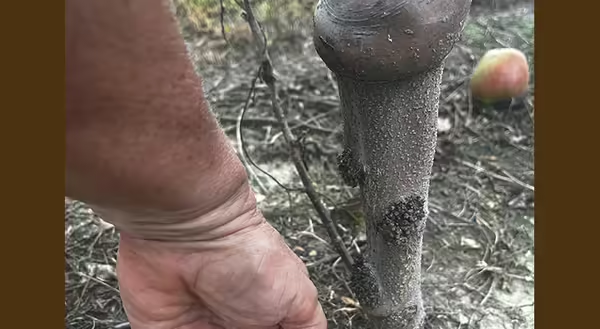
The level or tendency to form burr knots is usually a noted characteristic for each of the different apple rootstocks, but what is burr knot and why is it a concern? Burr knot can be described as an apple disorder that results in adventitious (formed accidentally or in an unusual anatomical position) root primordia that form on the aboveground portion of the rootstock or on the limbs. Genetics play a key role; some apple rootstocks and cultivars are more genetically susceptible or prone to developing burr knots, and it appears to be more so with those that root more easily from cuttings. Burr knots usually form during the year of planting to the shaded portions of the tree, especially when humidity and temperatures are high. Over time, the mass of root initials develops into roughened, warty growths that expand and coalesce as the tree ages, which in turn can result in a stunted tree or limit phloem/sugar transport to the affected portion of the tree. The burr knots can also become a point of structural weakness, potentially causing a break under a heavy crop load and/or heavy winds. The burrs are also known to provide a point of entry for damaging pests like woolly apple aphid, dogwood borer, and fire blight. In this photo, burr knots are seen developing on high grafted B.10 rootstock (photo credit: E. Wahle, Illinois Extension 2024)
Most recommended control measures are preventative, including choosing a resistant rootstock. Of the dwarfing rootstocks, M.9 is noted for forming burr knots and initial observations of B.10 in local orchards suggest it is as well. Of the semi-dwarf rootstocks, M.7, M.26, MM.106 and MM.111 are noted as burr knot susceptible. Additional precautions include placing the graft union as close to the ground as possible (reduce area for galls to form), but not so close scion rooting occurs; and promoting rapid drying (remove tree guards, reduce shade, maintain weed free plant row, maximize air flow, etc).
In my research looking for any curative control measures, it should be noted I came across an older (1983) research paper (click on link and it will automatically download) out of California where they found Gallex (AgBioChem) was effective in arresting the development of burr knots on MM.111 and MM.106. Our climate is significantly different, but it may be worthwhile to trial for effectiveness in the Midwest.